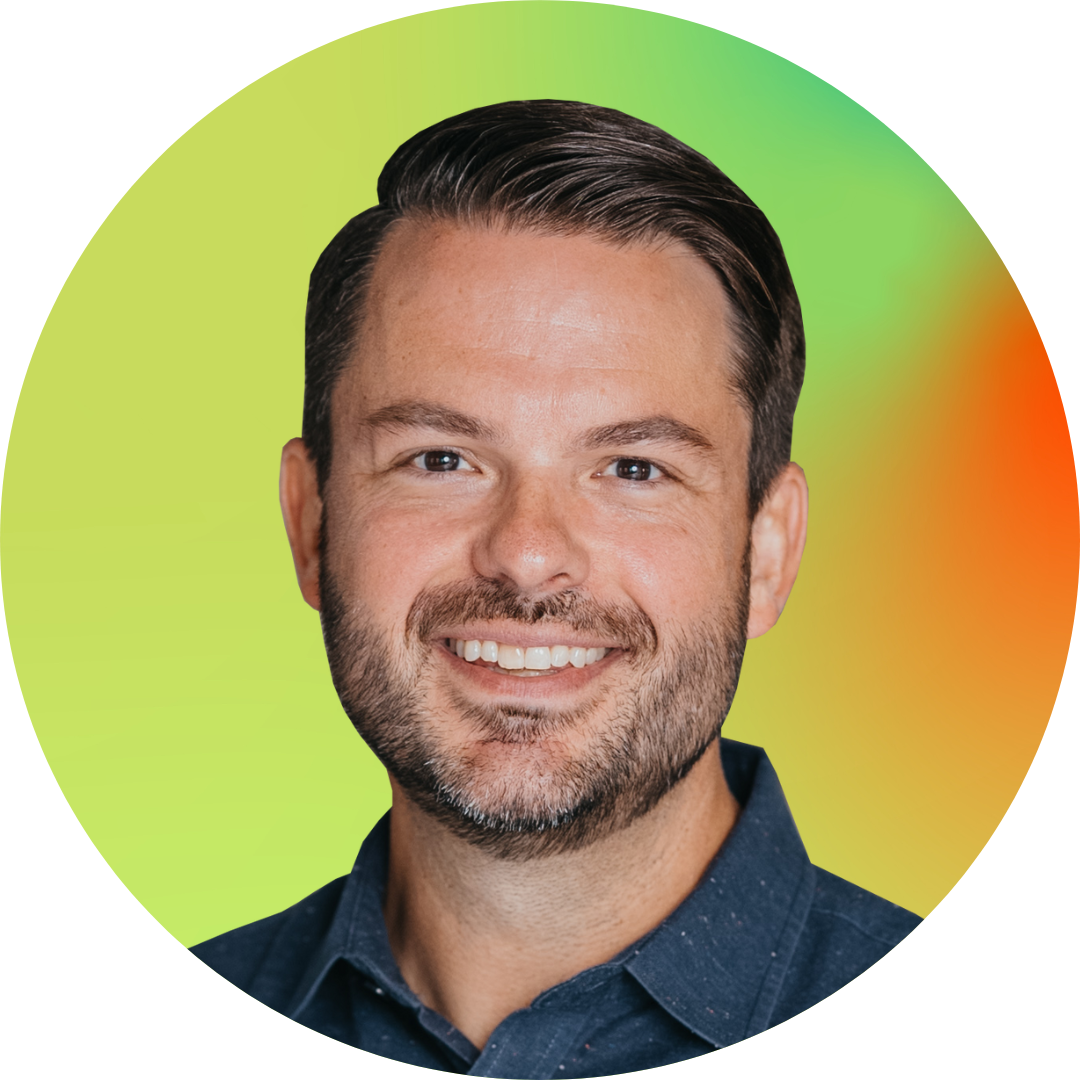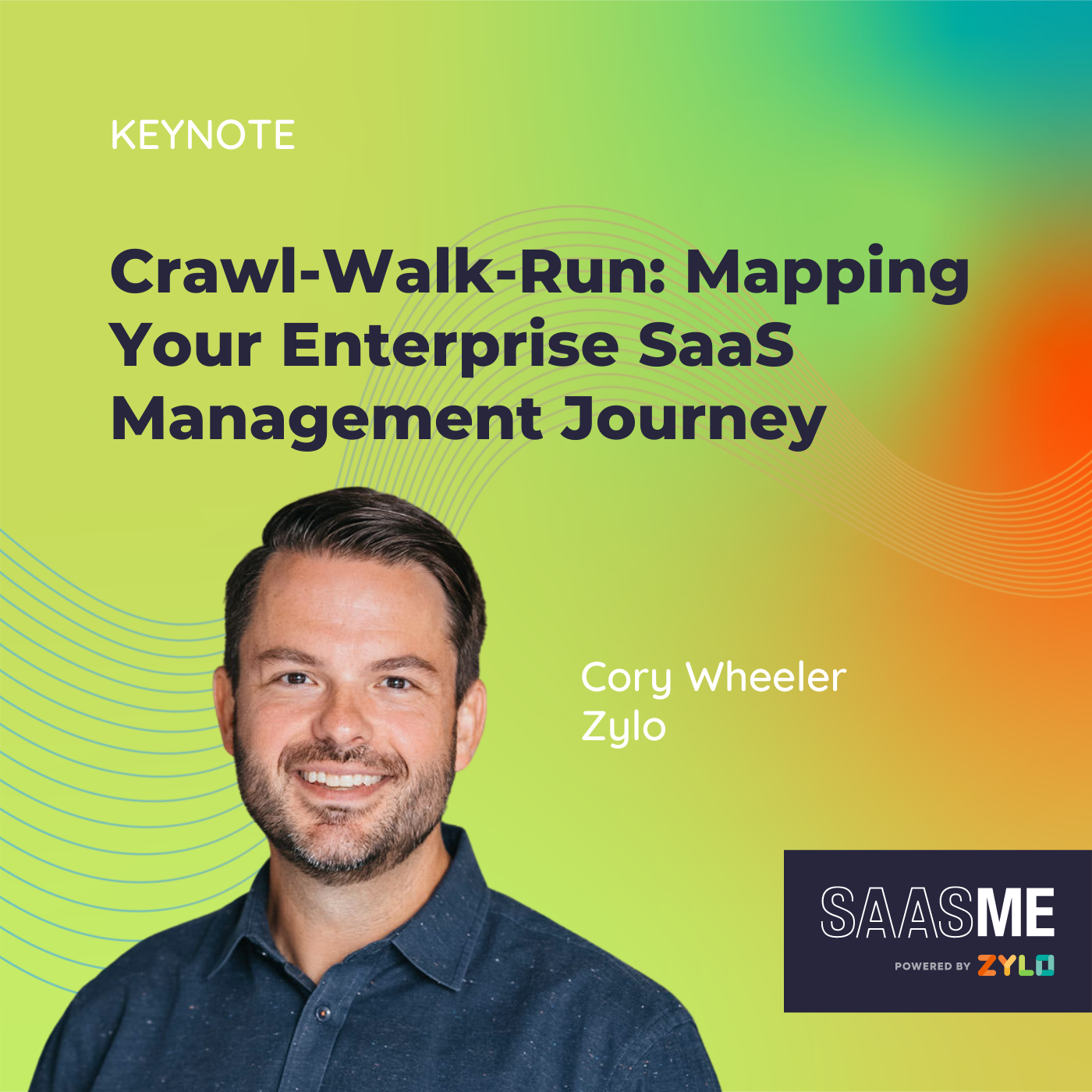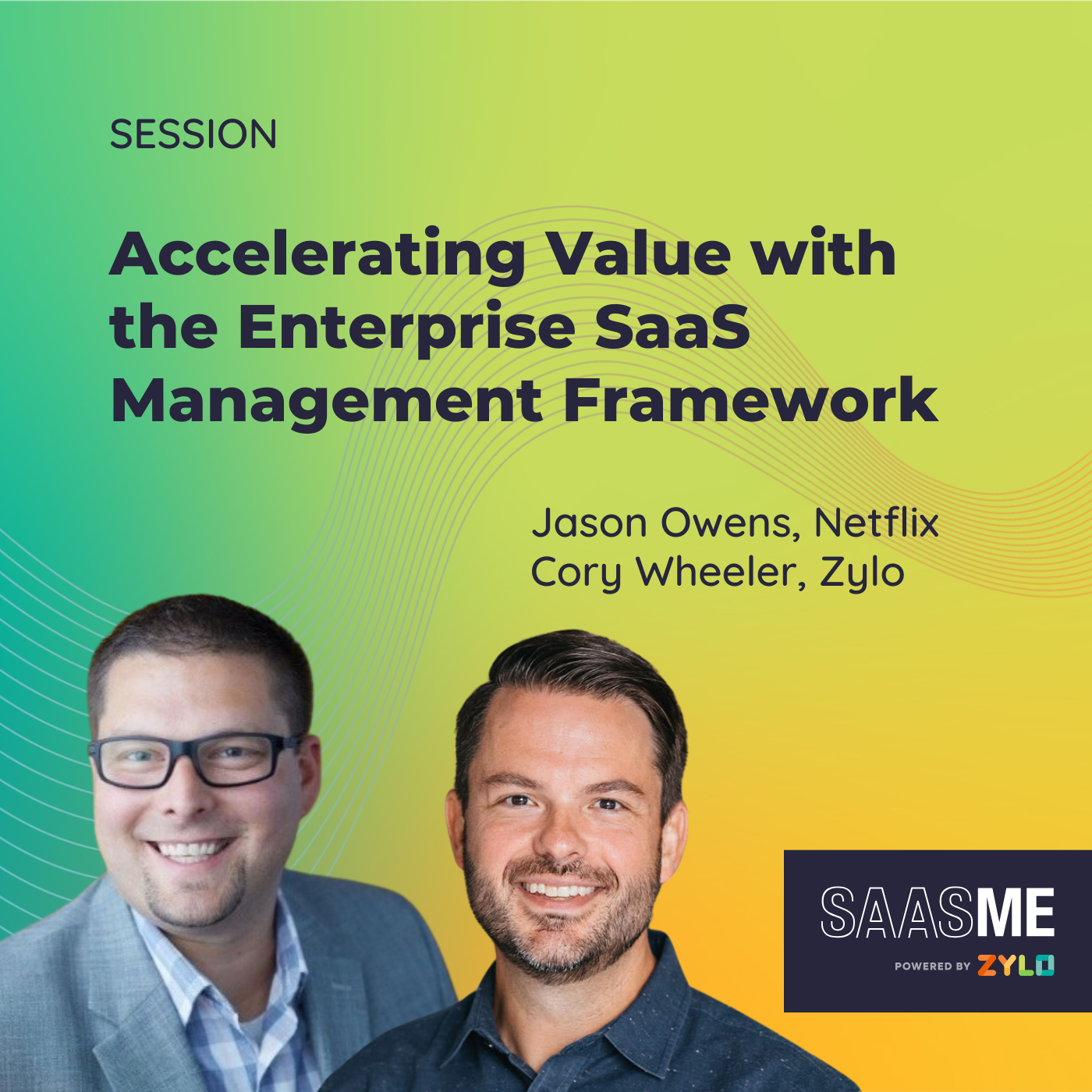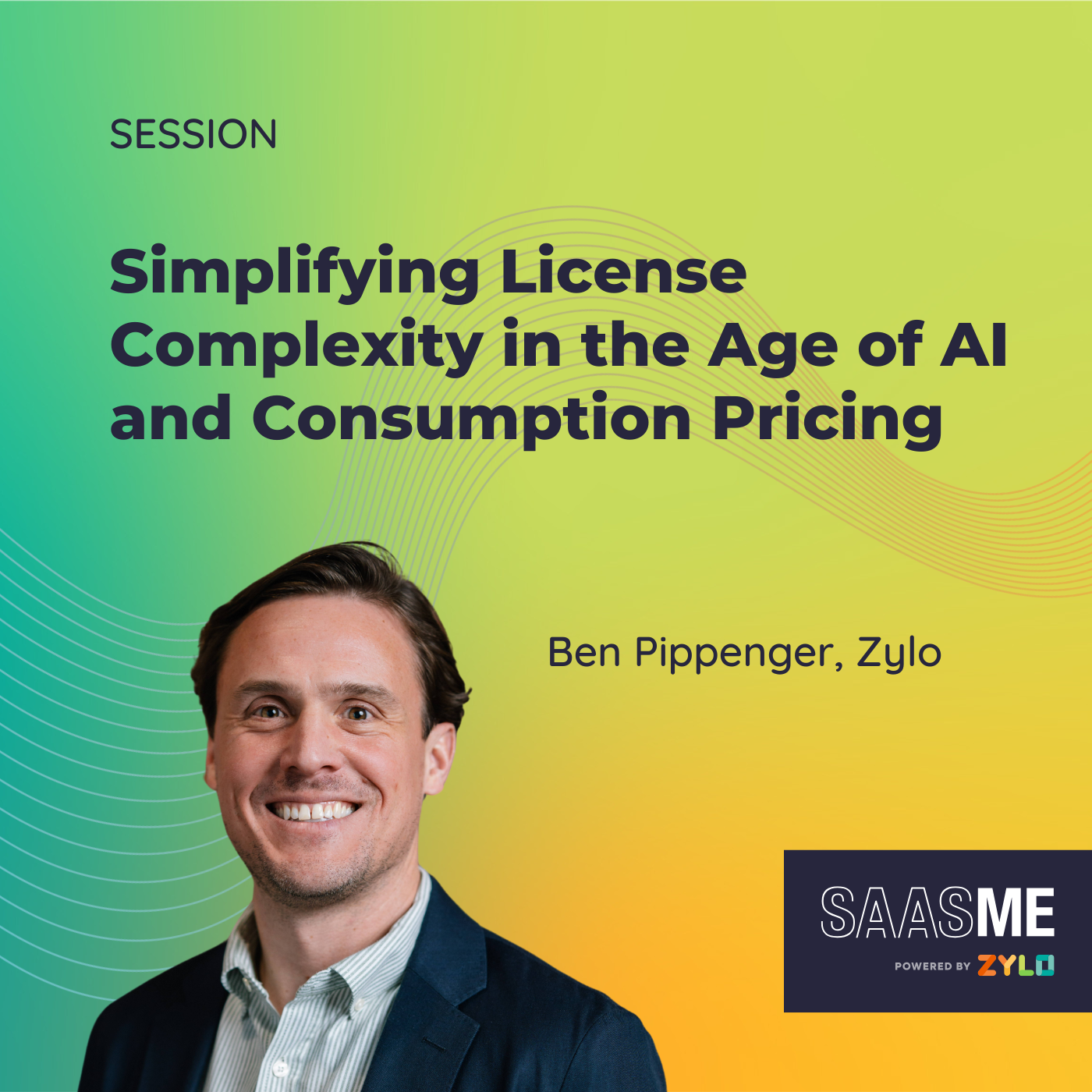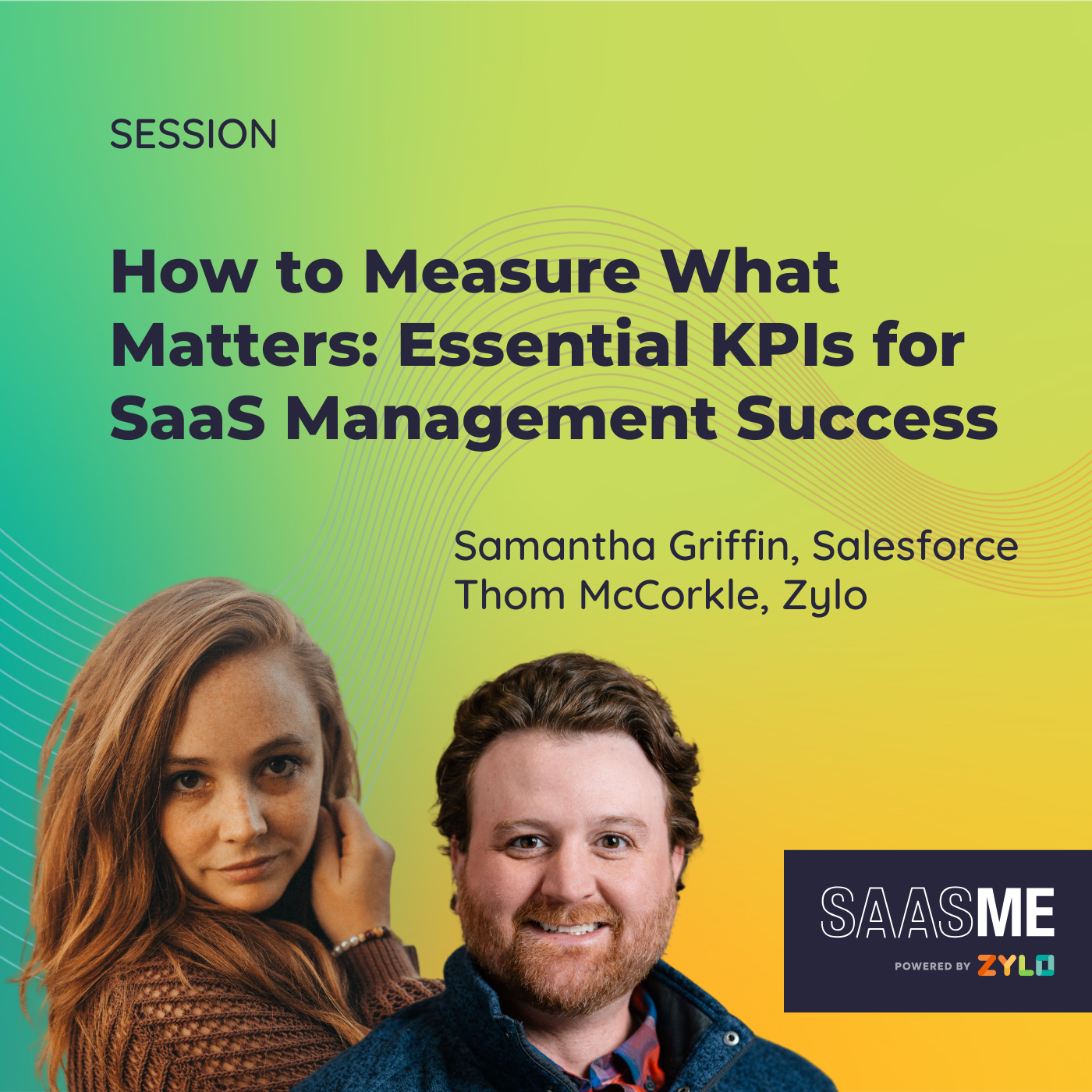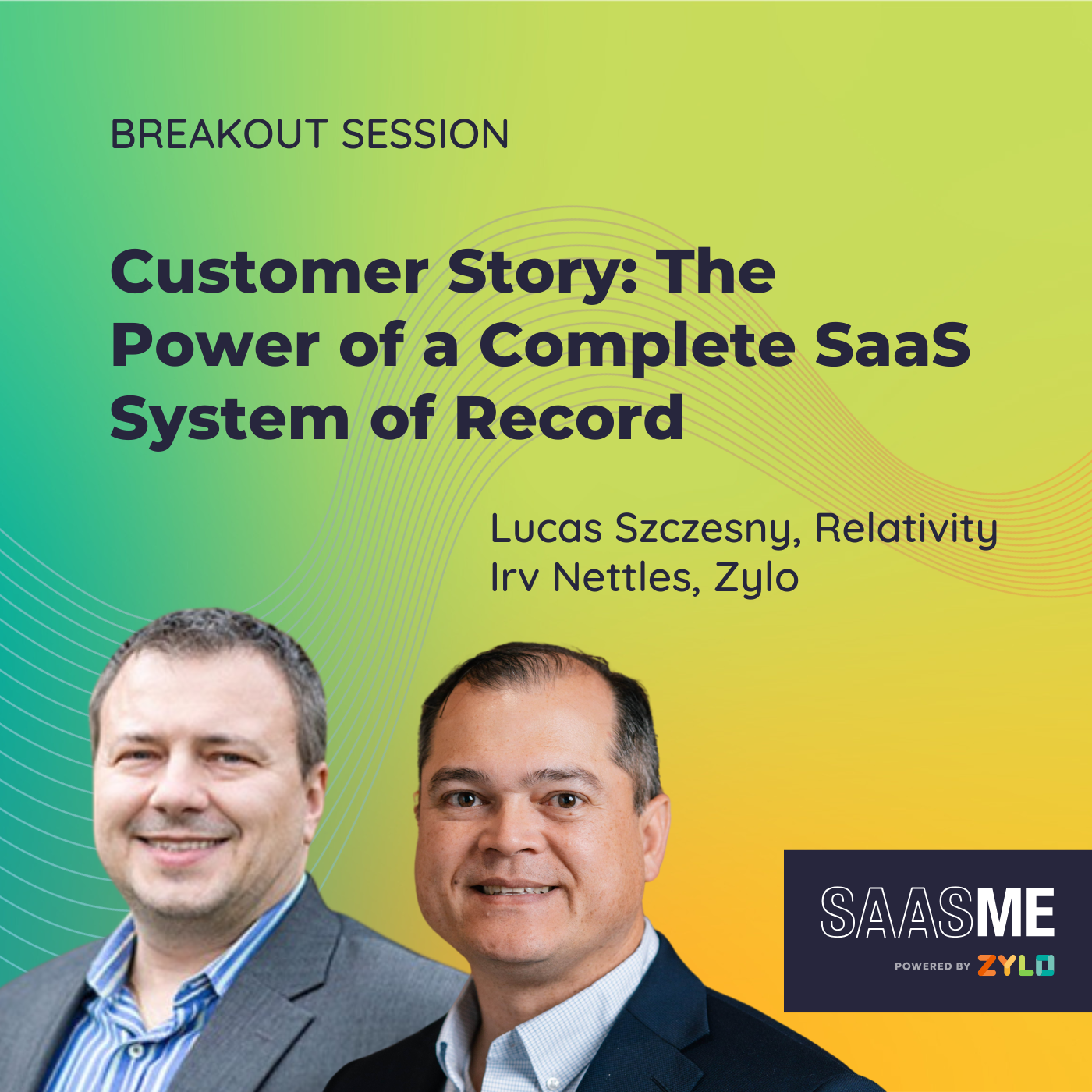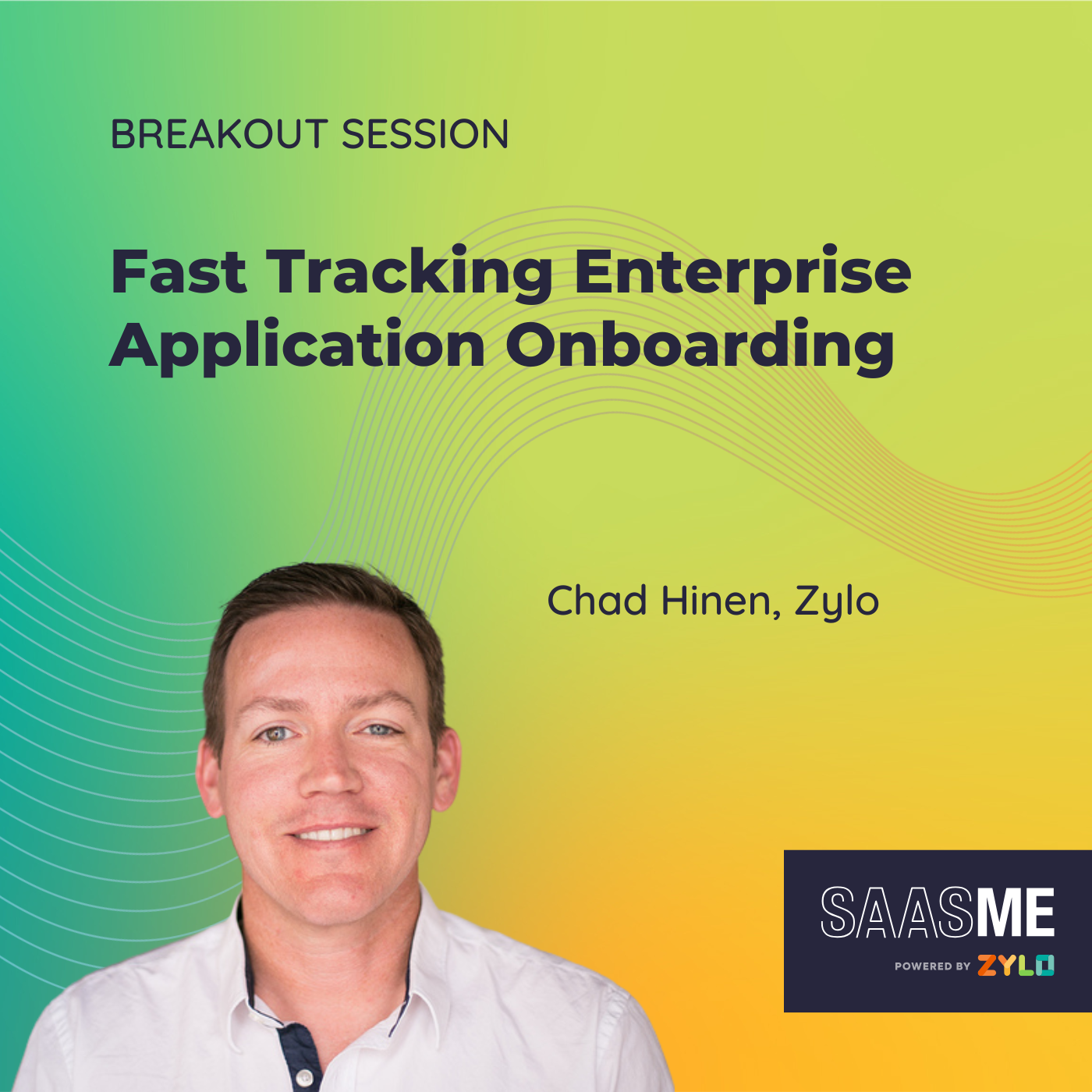Crawl-Walk-Run: Mapping Your Enterprise SaaS Management Journey
- 0.5
- 1
- 1.25
- 1.5
- 1.75
- 2
Cory Wheeler: Thanks so much for the introduction, Meredith. Hello everyone. Welcome to SaaSMe. It's really exciting to be able to present on a topic very near and dear to my heart.
Cory Wheeler: Crawl, walk, run, really mapping out that enterprise SaaS management journey inside your business. We'll take six years of enterprise implementations and success and translate that into a consumable way in which you can think about managing SaaS and building a program inside your organization.
Cory Wheeler: I'm Cory Wheeler, the co- founder and chief customer officer here at Zylo. Prior to Zylo I spent many, many years in finance and procurement related roles, living the problem that a lot of you today on the line are also living. Managing a distributed area of assets, managing software as a service throughout an organization, putting a strategic initiative around that, putting in operational initiative around that, and driving optimization every step of the way.
Cory Wheeler: As most of you that know me know, I'm incredibly passionate about SaaS management. I think it is one of the biggest opportunities that has hit the corporate space from small companies all the way up to major enterprises in the last couple decades from a tooling perspective all the way through to a management perspective. So it's wonderful to be able to speak on this topic today.
Cory Wheeler: Well let's get into it. When we talk about the explosion of SaaS, I think everybody understands that. There's a lot of SaaS out there. But what we really start to look at when we're thinking about the explosion of SaaS is not only the spend in the application counts. We're going to run through that here. But we're also talking about the administration, the overhead, the proliferation, the employee efficiency around software as a service as well. As your SaaS estate expands, so does all of those different capabilities that I mentioned.
Cory Wheeler: So let's take a look at the numbers. If you are a high growth small organization or commercial organization, under a thousand employees, today, we see across our customer base, you're spending about$ 15 million. You've got a couple hundred applications in house. Heck here at Zylo, we've got numbers that are starting to rival a lot of those as well. When you're from 1, 000 to 5, 000 employees, internally those numbers start to really grow. 330 applications on average, and now you're looking at more like$ 42 million in spend. And our large enterprise customers, you really see that proliferation grow. As you have employees that are distributed, they're using tooling that is distributed as well. Over 600 applications in use in the typical enterprise, with some of our enterprise customers, hopefully on the line today leveraging many, many more than that. But 250, nearly$ 250 million in annual expense, that's opex, every year. Opex is very flexible, so we'll get into how we talk about that as well. And the average customer seeing over 300 applications, approaching$ 65 million in total spend. This is proof. These are the numbers that the explosion of SaaS is already here. But for every one of these applications, 300 plus, you're not only using those applications, you're bringing them into your organization, onboarding them, offboarding them. You're managing that life cycle internally. You're managing the overhead around those renewals typically each and every year.
Cory Wheeler: So the explosion of SaaS has created a lot of new challenges inside most organizations. And what we know is nearly every organization out there today looks a little bit like this, applications all over the business. It is a fully distributed category inside most organizations, where your HR, your product and engineering, your sales and finance teams, they're leveraging the tools they need to get their jobs done. And that will never change. The management around that will.
Cory Wheeler: But the problems that our customers and our prospects and nearly every organization are seeing today is uncontrolled spend. We shared those spend statistics previously, just not knowing what you spend inside your organization, a lack of visibility. You've got redundancies across your business and overlaps, underutilized applications, risk everywhere through shadow IT. Renewals. Renewals are a very important part of managing software internally. And do you have a centralized renewal process that takes into account all of the requirements around not just renewing the software and the price point, but also bringing that in house in the right way?
Cory Wheeler: Sprawl, inefficiencies, and ineffective software is the end result. Software as a service is wonderful, but it has created a lot of organizational challenges because the workplace is now SaaS. Everything you do takes place in applications, and the ability to drive this is critically important. But wait, right? SaaS management is here. SaaS management is already gaining momentum in the market.
Cory Wheeler: And what we've seen as an organization implementing hundreds of enterprise customers is that the practice of SaaS management is becoming a practice inside different functions today. We see it most often within software asset management and ITM teams really upstream in our enterprise segment.
Cory Wheeler: Procurement, as this is a little bit near and dear to my heart, procurement manages the renewal life cycle for many or most or all of the applications inside your company today. IT, pure play IT really is having to own the strategy. They're accountable to the risk. They've got to have an answer to what applications do we have, how efficient are they, and how are our employees leveraging those internally? Enterprise architecture, mapping the capabilities to their products, to their internal functions, understanding what applications are being leveraged, leveraged well, that drive their go to market, that drive their product strategies. Enterprise architecture needs to understand those flow of applications, and then application management teams inside it as well.
Cory Wheeler: The practice of SaaS management is here and it sits inside functions today. But what ties that all together is really the fundamental understanding that software will never be owned or controlled by a single organization internally in most companies. What we do know is IT and finance lead it together. It's a team sport. IT is responsible and accountable to the risk inside organizations today. Finance is accountable to the optimization, the orchestration, the budgeting, and the proactive planning around software today. Both of these personas today struggle with visibility, whether it's putting together budgets and predictive forecasts, or whether it's putting together a full enterprise architecture strategy. Those two organizations will continue to co- lead this very strategic area going forward. And why? Well, what we know is there's a massive opportunity out there.
Cory Wheeler: The SaaS value opportunity, it's real, it's here, but where that begins is full, continuous, comprehensive visibility into your entire stack in real time. And as we think about that from a persona perspective, we see the following personas that are the key high level personas that are leveraging a SaaS management strategy, that are implementing a SaaS management practice in their business. And the use cases there are very, very clear. IT really needs to understand application value and the adoption of the products inside their business. They need to know that they have the right applications internally in their business. They need to see those redundancies and those potential inefficiencies as well. They've got an accountability to creating an environment where the employee is empowered to select the software they need, to engage those employees at the right time so they can get the software they need as well. They manage the on and off boarding of applications and the compliance and security, and I can't underscore that enough.
Cory Wheeler: The CIO is accountable to the security of the organization through the use of technology and tooling. When we think about that procurement and software asset management team, procurement in many circumstances sits in finance. Software asset management in many circumstances sits in IT. But the real core capabilities that they're executing each and every day are very, very similar. They're accountable to large renewals, they're accountable to cost optimization and cost avoidance. They're accountable to being able to audit these software titles at any point. And they also have a very real perspective on demand management. Do we need this application? One of our customers that we went live with a very large enterprise had 48 different project management solutions that were heavily in use inside the organization. Do you need that 49th or 50th project management solution when you go live?
Cory Wheeler: Procurement and SAM teams have those same similar types of core competencies that they're executing around their stack. And finance teams, you must be able to optimize opex. I think we're in an economic climate right now, certainly we see it across our customer base where budgets and opex are under review, they're under the microscope. And that is we are holding opex flat or reduced in the coming year because that is the lever you've got when there is any level of economic uncertainty to be able to reign in spend. Opex by definition is flexible and the ability to really drive change and action on it allows companies to spin up software, but also allows them to manage these costs in a much more predictive and fast way.
Cory Wheeler: Finance needs to be able to forecast, to not be over budget halfway through the year with software costs that were unknown. To be able to do proactive budget planning. I think a lot of us are in budget planning right now. We hear many of our customers as we reach the fall starting to button those up by the end of September or October. Right now is the time when the visibility into all of this spend and all of these applications is business critical. The person with the data wins. The person with the data has the intelligence to be able to drive that comprehensive strategy. Finance wants to cut out overlapping, redundant, duplicative tools, and they really want to be able to drive savings. And we do that today via many different ways in the platforms, but finance always has that eye on optimization.
Cory Wheeler: So let's talk about SaaS management. What is it? And before you can start to talk about crawling and walking and running and getting your program in place, you've got to define what SaaS management is. And luckily the folks at Zylo have been able to do that. If you go out and Google that today, SaaS management's defined as the business practice of proactively monitoring, managing the purchasing, onboarding, licensing, renewals, offboarding of SaaS. And that's a really good definition. It's the employee life cycle, it's the application life cycle as it relates to software as a service. And you've got to be proactive. You have to monitor, but you also have to be able to manage. You have to purchase and renew. You've got to bring an application internally and manage those licenses through that life cycle. And then you've got to off board and protect your organization. So it's really comprehensive that crosses many different organizations and those value props internally. And this is what it looks like.
Cory Wheeler: Today at the top of your screen SaaS is everywhere in your business. And what you've got to be able to do as a first step is be able to understand all of that. And certainly that begins with the SaaS management platform perspective. Hopefully that's Zylo. What we know is that taking all of this unstructured data, bringing together spend information and utilization detail and entitlement detail, the three legs of the stool, and pumping that through a system that allows you to get to comprehensive discovery is vital. It's table stakes. You can't get 80% of the way there. You can't get 85% of the way there. To be able to put a comprehensive strategy around what are our people using, what are our teams and departments using, how are they using that, and how is it working in the environment, you have to have comprehensive visibility. And this really illustrates that double value prop with the CIO and the CFO. As you understand your full application stack and you build that in your SaaS system of record, looking over to the left, the CIO is accountable to those adoption outcomes, utilization outcomes. They're on and offboarding those apps. They're managing the owners of each and every one of those applications, because if you have 700 apps in your environment, you probably have 500 different owners of all of that software.
Cory Wheeler: So the CIO wants to drive app rationalization, get rid of shadow IT, and start to standardize to drive employee efficiency. They're accountable to operations. The request of licensing, the deprovisioning and provisioning of licensing on the front and the back end of the license life cycle. They're accountable to risk management. And all of that comes from a single SaaS system of record. On the finance side, it's renewals, clear and present. It's getting those insights and managing all of the contracts, cost reduction, and cost avoidance. So that unstructured data really sets up both of those organizations to drive SaaS management success.
Cory Wheeler: But let's get into the journey. Usually one of the number one questions that a CIO, CFO, head of IT or finance and procurement will tell me is," You've done this before. How do we think about this? The insights that you're showing us across our entire stack are almost overwhelming. We knew we had a problem, but you are pointing out a problem far larger than we ever even realized." Well, the reality is enterprise SaaS management does happen on a bit of a spectrum, and we've broken it down into a very consumable practice that our customers can review and implement in their business.
Cory Wheeler: And those four stages are really about implementation. And typically you'd throw implementation and say," Oh yeah, you're just implementing something." But the activity of bringing all of that data together is critical. It's vital. I would say it sets the stage for how well you're going to be able to drive SaaS management in the future.
Cory Wheeler: From there, once you're implemented, organization becomes first and foremost to be able to drive. What you'll find is the chaos that you anticipated, that you thought might be there, is very much inside your organization, whether it's employees purchasing the same software, 10 employees expensing the same software, multiple cost centers buying outside of a centralized agreement. That organization allows you to clean things up once you have that full discovery.
Cory Wheeler: That third step is optimization. Building a repeatable, programmatic optimization engine that not only drives value for your organization, it justifies the program to be able to drive a lot of that fourth stage, which is orchestration.
Cory Wheeler: Orchestration is all about taking this data and pushing it out to your business, getting employees the application they need when they need it. Really being able to take centralized data and distributing it out to your organization in the same way that SaaS is purchased. It's distributed and used in a very distributed way today. You've got to be able to orchestrate this data and provide data to the right people at the right time when they need to use them.
Cory Wheeler: So let's double click into this as well. When we talk about implementation, we're really talking about building that foundation. And you can see, integrate, centralize, and transform that data. But when we look at the steps that we think about during an implementation process, that first step is to centralize that data. It is pulling together all of your spend detail through multiple systems. It's pulling together your utilization data, your single sign on data, as well as those contract entitlements.
Cory Wheeler: And that is the beginning of your SaaS system of record. There's a system of record for your employees, there's a system of record for your customers. You've got a marketing cloud, you've got a service cloud, you've got a sales cloud. But what runs all of this is software. And if you think about a SaaS system of record, because SaaS touches every organization, having some central solution of continuous and ongoing visibility is critical. From there, you're able to identify all of the spend, the second point here. You really need to understand spend because on the finance and procurement side, that's how you're baking in optimization goals and predicting when and how you're going to tighten up that opex belt. From an IT perspective, identifying the spend allows you to prioritize.
Cory Wheeler: Every IT leader we talk to, when we start thinking about how do we want to optimize your applications, you're always doing a reverse sort on that spend column and looking at where you spend the most. So spend is critical to being able to discover, but also to prioritization inside your business. You've got to understand that SaaS sprawl. Implementation gives you that first view of shadow IT. You'll see every application that employees are expensing. You'll see the redundancy that creates within your business. This implementation will give you the knowledge around what do we spend, how many apps do we have, how many risky apps do we have, and this phase allows you to begin to set up those KPIs and those goals that you're going to drive to as part of a programmatic implementation. You're going to be able to start to act on license utilization.
Cory Wheeler: So when you're implementing, you're still looking at the results of that utilization detail and actioning on that, leveraging tools within your SaaS management platform directly in Zylo today. You're going to understand the SaaS adoption. Your biggest applications better have that 90% plus utilization rate. Your line of business apps, are they needed? If you have 25 different project management tools, how are they being leveraged in your business? Critical to implementation. And during implementation is when you build your SaaS renewal calendar.
Cory Wheeler: When we talk about insights, and we'll get to the optimization section, you've really got to be able to take advantage of insights at the point of action, and for software as a service, that's very clearly the renewal process, the renewal calendar. So that makes all of these insights actionable and translates to time- based programmatic predictive results. And we'll get into that.
Cory Wheeler: We've got wonderful customer stories, whether it's a smaller customer that an IT organization implemented in less than 30 days, discovered their applications, and started driving benchmarks on day one, or it's a mid- market company still in IT that came together via M& A and drove that full discovery of each of their affiliates. Or it's a very large biotech organization that saved $500, 000 during implementation. I hope all of you are on the line today as well.
Cory Wheeler: Implementation, you're still creating value, you're still moving forward, but you're aggregating this data to drive an overall strategy. From there, you move into organization. What you'll find during any sort of implementation process are a lot of what we'll call surprises. And this is how we start to put a strategy around those surprises. First, you've got to classify your applications. Who owns it? Your IT, your line of business, your end user. Attribute that ownership. Start to organize where these applications sit, where co- owners, and where they belong in the organization. Your enterprise architecture team will love you for this.
Cory Wheeler: You're going to see what shadow IT exists in your environment. You're going to be able to begin remediation planning on that right away. Your shadow IT are your riskiest purchases, probably the purchases that you're spending the least on, but represent the largest risk inside your organization today. You're going to be able to build that SaaS renewal management calendar and centralize it. It is then during that organized phase that you're leveraging yourself appropriately. You're looking at where there's distributed spend and bringing it together to make a full leveraged purchase actionable. You're identifying those purchasing inefficiencies. Where do you have a contract in place and you have five people that are expensing a product? Where do you have 15 cost centers buying the same solution, maybe not on the same contract? Pulling all of these insights together helps you clean up your environment. You're going to look at the redundancies. You're going to start to address where do we need best in breed versus full platform capability inside our business?
Cory Wheeler: And last but not least, this is when you begin to benchmark. You're going to optimize... Or sorry, you're going to plan on what that optimization schedule looks like. Do we spend in SaaS the same as our cohort of customers? Do we use these applications in the same way? Do we have the right stack or are we actioning on the best price that we can as we look at our application across the business? The organization phase is a time to start driving optimization, but really cleaning up that stack. And our customers show that as well. Whether on the under a thousand segment customer side, they've already had$ 5 million in app rationalization during that organized phase. Or a real estate tech company in our middle segment where IT and procurement come together to really drive a comprehensive strategy. They've been able to drive huge strategy and fully leveraging themselves, whether it's PagerDuty, Zoom, Salesforce, or their M&A and a process to drive that overall optimization.
Cory Wheeler: And finally, large organizations driving SAM results in the organized phase, saving on licenses, mapping out app owners, doing security reviews, and then centralizing that SaaS renewal management. This all feeds into that third phase, which is optimized. It's where I get pretty excited. The optimized phase is really about building, as I mentioned earlier, the ongoing engine.
Cory Wheeler: Self- sustaining practices that are always ongoing. It's about building a SaaS renewal calendar that is dependable, reliable, repeatable, programmatic. Use the word that you would like. But by having a SaaS renewal calendar, with insights mapped into every single renewal, you can begin to understand what is our financial liability quarter over quarter, what are the insights and opportunities we have quarter over quarter, and you're driving optimization on every renewal. And at the end of the year, that adds up to massive ROI. And then at the end of the year, that adds up to pure play justification for your program, the next steps in your program, the ongoing engine that will continue to deliver.
Cory Wheeler: SaaS is turning over on average every three years. You've got renewals coming up every year. You've got employee numbers shifting. So the thought that you can optimize once and not be able to come back to it a year or three years later, that no longer exists. You're having to manage every single renewal. But now you can look at where those renewals are, how much you're saving, start to forecast those numbers, deliver on those numbers, and when you're the one coming in with those results, that fuels the entirety of the rest of your strategy. And you do that through the steps that we've outlined. You're proactively pulling back licenses via workflows, automated workflows in the platform. You're addressing and picking the right applications. You're implementing demand management. Do we really need every one of these apps? A lot of our customers out there have a software review board leveraging the full inventory that they see in Zylo to ask those questions.
Cory Wheeler: You're looking at benchmarking those savings opportunities, price benchmarking. Ensure that you're negotiating and you're buying with confidence. You've always got that auditing system of record to the fifth point here, which allows you to stay on top of shadow IT and on top of licensing as well. And as that last step, you're really road mapping your single sign on solution as well. Put more behind Okta, put more behind OneLogin. Drive more value out of your SSO investment by pulling that log in detail into Zylo and actioning on that data. And the optimization customer stories are fantastic. Whether you are in our commercial segment, saving$ 1. 5 million already on a pretty small software expense.
Cory Wheeler: You might be in our mid- market, with an IT organization that built an entire SaaS management function. SaaS management is a function within their business. They said that Zylo provides the flexibility to run SaaS management their way, through the use of custom fields and filters and saved filters and the depth that we provide in our subscription grid. And they created a set of operational rhythms that every month they're undergoing a few different activities that ensure they're staying on top of their stack. So phenomenal job there.
Cory Wheeler: As we move up market, we have a pharmaceutical organization, over 10, 000 employees, that's already 10 million in value. Whether it's on license reclamations, a lot of value there for Salesforce. Cost avoidance, being able to pull licenses back that aren't being used so you don't renew those. App rationalization, finding, uncovering, and deprecating redundant services. Or remediating shadow IT. This organization, very large, has cut their shadow IT in half.
Cory Wheeler: So these stories are consistent across our customer base, leveraging this data. But they really power the ability for you to be able to then take the data and orchestrate it out throughout your business. Take the distributed category, start to empower your IT teams, your individual employees, your sales ops and marketing ops teams. And how do you do that? Really reiterating the first point of a centralized SaaS system of record.
Cory Wheeler: What we always want to do as part of a SaaS management program is bring in people like enterprise architecture, legal, security, FP& A, procurement. You've got to bring in all the functions that really are affected by SaaS and have a place around SaaS and centralize them in a single solution. You've got to map those capabilities, this is that enterprise architecture use case, that you're mapping the right apps to the right internal capabilities. You're able to then build budgeting and forecasting with your FP& A team and your budget leaders and take that out at the cost center level. You're empowering your employees. We've created an employee facing SaaS catalog. One of the earliest questions we received as a business was," My employees don't even know what they can purchase, what they can select. So they go out, they swipe their credit card and they bring it in."
Cory Wheeler: So by creating an employee facing SaaS catalog and curating the data out of Zylo into your catalog, you are now putting that visibility in front of your employees, leveraging the same tools you have to fulfill those licenses today. But you're really creating that empowerment for your employees. And finally, the democratization of SaaS data. This data isn't just for IT and finance teams. You've got to give the right visibility to the right people at the right time, leveraging views and permissions and getting this data out in front of your operational teams. They can make the right decision. They can drive the strategic outcomes around SaaS management.
Cory Wheeler: The orchestration phase, I don't think we're doing it as much justice as we should on this slide. I think there are so many things that you can do with this data, with the outcomes, and with the knowledge of the central SaaS system of record. And our customers have done just that. Whether you're a software company with IT, procurement, finance, and compliance, empowering your users via app catalog. You're another software company in the middle that is doing a very similar data driven approach and building out a system of record, delivering a million dollars in savings very quickly in year one. Or you are a very large organization all the way to the right, building an entire life cycle process with requesting, fulfillment, optimization, and centralized tracking.
Cory Wheeler: Orchestrating this data is that end state of truly being able to understand, optimize, and then create additional value on top of your SaaS management structure. But don't forget, you've got to have some enabling factors here. And what we see when we're implementing customer after customer, as I mentioned hundreds of enterprise customers, is executive sponsorship is important.
Cory Wheeler: Because this is a distributed category, you've got to have a CIO and a CFO that understand the problems, that are looking at budgets, or that are looking at employee efficiency in sprawl. That are able to set outcomes and KPIs that you can meet on and drive to. That executive sponsorship is always needed because there isn't any central clear ownership. So the CIO and the CFO play a very strong role here. You've got to focus on it. I've told our customer base time and time again, plugging in a solution doesn't quite mean that dollars fall out of the sky with any level of effort. So you've got to really focus on that. You've got got a renewal process that's moving. You've got 600 renewals that are going through every year. That's three renewals every single business day. So you've got to have a focus and dedication around what many know is the number one expense line item underneath head count. We've got a lot of customers at Zylo today that are looking at optimization, and that's where they go and look, in opex.
Cory Wheeler: And finally, pull in your application owners. Talk about the value of centralization of all of this data. Bring them in as part of the project.
Cory Wheeler: And what I want to leave you with is that final takeaway. SaaS management is not a project, it's not a tool. It's not a neat little thing or a quarterly initiative. It is an ongoing practice. You've got a life cycle of 600, 300, 2000 applications that are renewing every year that you've got to be able to optimize, you've got to get the right data into the right people's hands, you've got to minimize the risk to your business, and you've got to do that at scale. SaaS management is here, it's a practice, and definitely not a project.
Cory Wheeler: Thank you all so much for your time today. Enjoy the rest of the time at SaaSMe, and I will see you again here real soon.
DESCRIPTION
It was Ralph Waldo Emerson who said, “Life is a journey, not a destination.” Zylo’s Chief Customer Officer Cory Wheeler would tell you that building a SaaS Management practice isn’t much different. In this session, Cory will walk attendees through the Enterprise SaaS Management journey. Whether you’re just starting out or a seasoned SaaS adventurer, this session will help you understand where you are in your journey today and provide insights to get to the next phase of maturity.
Today's Guests
